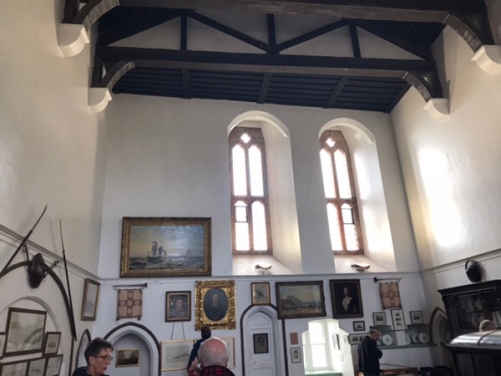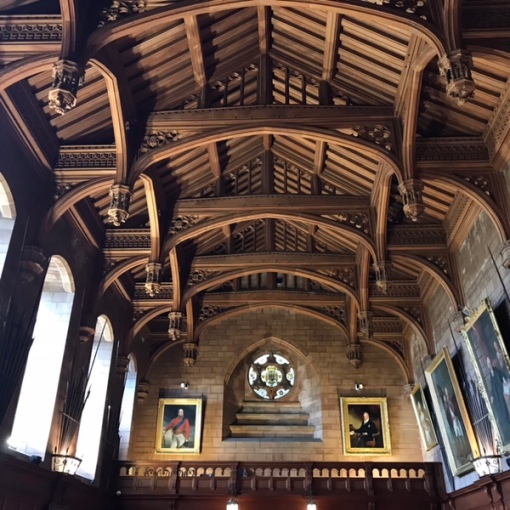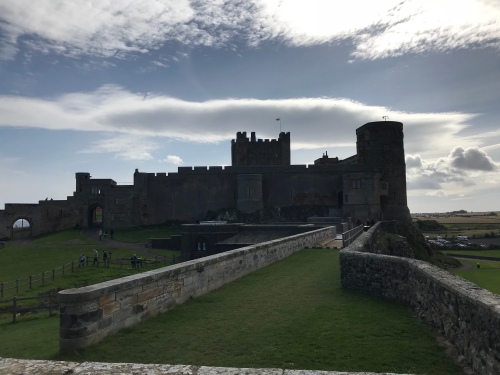
Part 2.
Rested, the group of pilgrims gathers beneath the vast presence of Bamburgh Castle. The castle was restored to its present glory by the 19th century munitions entrepreneur and inventor William Armstrong. Lord Armstrong bought it from the Crewe trustees in 1894 for the sum of £60,000 – a fortune then. He went on to spend a further one million pounds creating an iconic English castle which would be used as a convalescent home for ‘well educated people who had fallen on hard times’.
Armstrong’s descendants still own and use Bamburgh Castle, though they have other dwellings, too. They are very much a part of Northumberland’s life and social hierarchy.

The portrait above was painted in 1846 and hangs in the museum within the castle walls which is dedicated to his work.

But we are not here for history. We are here to engage with the now, in a way that invokes the surroundings as a metaphor of our ‘interior’ state.

Seen from the beach the previous evening, the castle was the embodiment of protection… but also, possibly, conformity and obedience. Its structure is heavy, fixed. Whatever ideas gave rise to its creation are reflected in its unyielding stonework. The way it has grown and evolved is an accurate parallel to how the egoic self arises and dominates.

On the Friday evening, In our minds, we created an image of a portcullis being raised, and a mental journey into the castle to locate a symbolic key that would epitomise our pilgrim’s journey from here to Lindisfarne. But we know that things will happen when we actually pass inside its walls…
Psychologically, we will be transformed from being free but vulnerable, outside; to being safe but caged, inside. It’s not a new dilemma. The very first cell of biological life created that polarisation – that duality. From then on, the vehicle of life – the final product of organic chemical organisation – would thrive, but only inside the container which allowed protection and persistence… The world of consciousness changed at that point- becoming dual: the in-here and the out-there.
Sea bacteria became plants. Plants became fish. Fish became land and sky animals and finally, mankind emerged. At each stage, nature built on the best of what had gone before, while still allowing diversity in all its glory. The castle supports and protects ‘the best’. The inheritance of its wealth and prestige mirrors the DNA that allows life to endure in a cellular world, but only in a material sense.

We pass through the heavy wooden door and are assimilated into the interior of the ancient building. From here, even as group leader, I cannot speak for any of my companion’s experiences. Each is here to experience for themselves; each will or won’t find a key emotional space within the castle.
The first of the two ‘small rooms’ is unimpressive. Weapons and paintings hang from plain, white walls. There is no connection here, no sense of a powerful emotion related to our weekend’s quest, no test for the pilgrim…. it is spartan in its ‘feel’.
It is only in the next room that I discover that these two ‘small rooms’ were once part of the kitchens, which explains their plainness.

The connecting corridors and staircases wind into the centre of the building. The ancient is mixed with the familiar and familial, such as this bronze of Lady Armstrong and her two children, crafted by sculptor and film maker David Rawnsley, who, earlier in his multi-talented career, had produced the famous wartime naval epic ‘In which we serve’. The film was based upon the life of Earl Mountbatten.
A warship would make another good model of the egoic self, I think to myself…

And then the nature of the interior changes. It becomes obvious that we are approaching a different part of the castle; one with very different functions.

The stone is somehow grander. The lustre of the wood is deeper. The final flight of stairs is steep and heralds a dramatic change of perspective as we emerge into the King’s Hall.

The roof of the great hall is what first catches your attention. The false hammer beam ceiling is made from Thai teak. The King of (then) Siam was a close friend of Lord Armstrong and is said to have personally helped with the intricate carving. The King’s hall has served as the main ballroom and function suite since Edwardian times. It contains a minstrel’s gallery to house the musicians.

The austerity of the previous two rooms is replaced by a physical and emotional warmth. This is a place you want to be. Though only the ‘best’ would get that right, of course. It is ours for a few minutes. Within that time we each need to decide its significance in the scheme of the weekend.

‘I’ feel very at home here. The opulence speaks of a place evolved to suit the needs and the feelings of a ruling class. That is not how I feel about myself, of course, but I can appreciate the effort and skill that has gone into its design. There’s little here that is new; it’s all traditional – and of very good quality. The sheer height of the ceiling casts a sense of ‘freedom’ about the place. We who live in low-ceilinged, modern houses forget how special this feels.

And then it hits me: how far in mind I am from the spirit of the group on the beach, the previous evening; how I have indentified with the quality of the contents in the hall. And there, now plainly visible, is the slow undermining of the search for the real Self that such luxury promotes. It’s quite natural to want to be comfortable, to appreciate quality things, but the purpose of this weekend is to make visible the working of the egoic self and its (literally) trappings.
Smiling, I do a little nod to the power in the room and leave…

The two martial figures, devoid of real content, couldn’t be better placed. Their presence is almost threatening: “Look, we’ve tried it the nice way, but you’re being stubborn.” They seem to say. “Just turn around and embrace the opulence… forget the other nonsense…”

Seen with a ‘normal’ eye, it’s just dark humour. But we don’t do these things to see with normal eyes; we try to see differently. Here’s a classic case: the finding of a key, the resolution to ‘leave it behind’ and then the act of running straight into authority. That’s exactly what the ego does to us when we challenge its position at our centre. It has a scary counterpart in the ‘superego’ – an internal authority figure that mimics someone in your life – like your mother or father; someone whose standards you can never live up to.
But the suits of armour have another attribute that fits them well with our search for metaphor: they may look fearsome but they are empty… And, in particular, they have no centre of being. They are just a shell, grown in reaction to life to protect us. But what protects also imprisons…

Now, my time is nearly up and I’m on a mission to leave, to get out of there. I have one more thing I want to do, and that’s outside the main body of the castle. I walk quickly though the remainder of the rooms on the higher level, looking for the exit staircase to the lower corridor.

But, just before the staircase there is a well – a very ancient well, mentioned in the History of the Kings of England and dated 774 AD. It is nearly 44 metres deep and two metres wide, and was cut through hard rock to reach the water-bearing sandstone, below, giving the castle its life-sustaining water for over a thousand years.
Suddenly, my subjective day has a very special connection with the objective world ‘out there’ and my hand slides over the wooden cover in a gesture of gratitude as I take the staircase and leave the castle.

At the far end of the interior grounds of the castle is a raised platform on which sits the old windmill. From it, I know I will get a view of the whole structure – just like being on the beach. For long minutes I stand and look back, restoring the perspective of the evening before. Then, conscious that the others will be gathering outside the halls, I walk to join them.

Stuart, one of my fellow directors of the Silent Eye School is there, already. He is sitting in a reproduction of the ancient royal throne of Bamburgh, reconstructed from a fragment found on the site. Behind him, the companions of the weekend are gathering after their own interior experiences. Whenever we can, we open such moments to any kind of reading or spoken observations. Poetry or prose is a popular choice. Stuart has on his knee a copy of Pilgrim’s Progress…
We gather and listen… It’s surprisingly apt.
To be continued.
©️Stephen Tanham
Other parts of this series:
Stephen Tanham is a director of the Silent Eye School of Consciousness, a not-for-profit organisation that helps people find a personal path to a deeper place within their internal and external lives.
The Silent Eye provides home-based, practical courses which are low-cost and personally supervised. The course materials and corresponding supervision are provided month by month without further commitment.
Steve’s personal blog, Sun in Gemini, is at stevetanham.wordpress.com.
You’ll find friends, poetry, literature and photography there…and some great guest posts on related topics.

Reblogged this on Jordy’s Streamings.
Thank you, Jordis. Hope you are well? x
Yes, couldn’t sleep after I got home from the hospital. But sleeping off and on today and no work for several weeks. Not the best way to get down time but after several months of excruciating pain, it is very welcome. I have my homework to dive into, a coloring book with verses from the Bible to study in a playful way, several books to read, the blogging world and my bed!! So I am all set, thank you, Steve!! Recovering now for April!! With Love, Jordis xx
So glad it’s gone well. We all send our love. Get lots of rest xxx
You always manage to discover such lovely and very special things on your travels!
We leave home ‘knowing’ they are out there…. and just have to find them! x
and I, for one am so glad you do…
Thank you, Jaye. We’re always that that you and Anita are with us in spirit x
That we are…
Next part out tomorrow…
Thank you, Sue x
This is so interesting 💜
Thank you, Willow. Part 3 tomorrow on stevetanham.wordpress.com
I am eagerly awaiting that💜